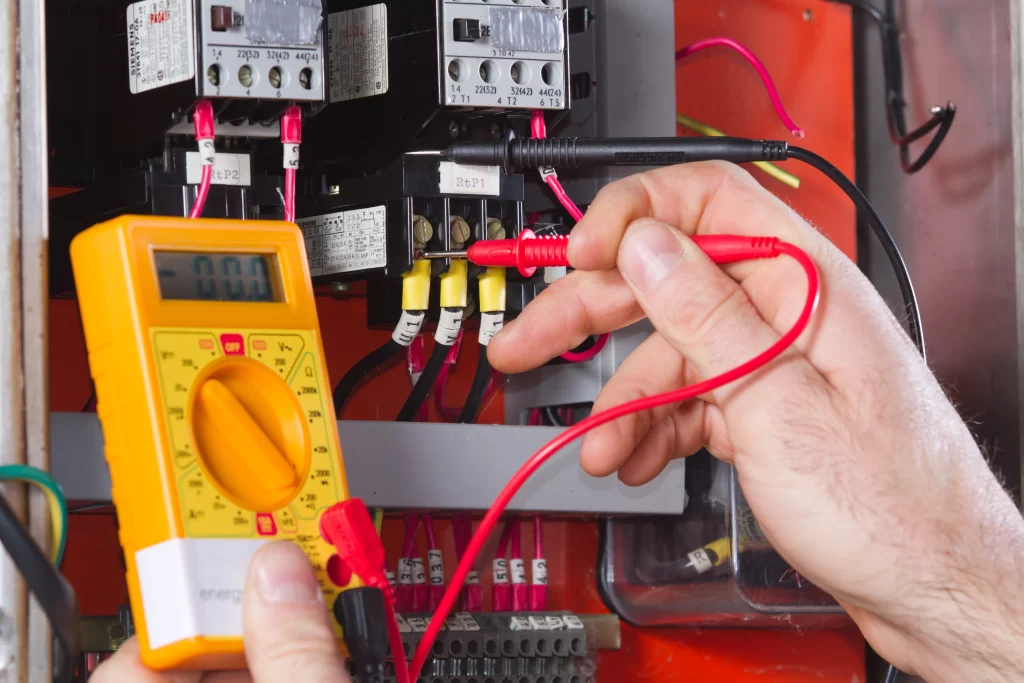Electrical Installation Work
Electrical Installation Work in Mumbai, Thane, Navi Mumbai, Nashik, Aurangabad, Nagpur and Maharashtra

Electrical installation involves the process of fitting electrical systems and equipment into a building or structure to ensure the safe and efficient distribution of electricity. Here’s a detailed description:
Components of Electrical Installation Work in Mumbai, Thane, Navi Mumbai, Nashik, Aurangabad, Nagpur and Maharashtra:
Electrical Installation Work in Mumbai, Thane, Navi Mumba,Nashik,Aurangabad, Nagpur and Maharashtra
Service Entry:
- The point where the electrical power from the utility company enters the building.
- Includes a meter, main disconnect switch, and overcurrent protection devices.
Distribution Board (Panel Board):
- A central panel where power is distributed to various circuits in the building.
- Contains circuit breakers or fuses for each circuit.
Wiring and Cabling:
- Conductors that carry electrical power throughout the building.
- Types include non-metallic sheathed cable, conduit, and armored cable.
- Includes grounding and bonding to ensure safety.
Outlets and Switches:
- Receptacles for plugging in electrical devices.
- Switches to control the flow of electricity to lights and appliances.
Lighting:
- Fixtures and fittings to provide illumination.
- Can include incandescent, fluorescent, LED, and smart lighting systems.
Appliances and Equipment:
- Major appliances like stoves, refrigerators, HVAC systems, and water heaters.
- Specialized equipment depending on the building’s use, such as office equipment or industrial machinery.
Steps in Electrical Installation:
Planning and Design:
- Assessing electrical loads and designing the system to meet requirements.
- Ensuring compliance with local codes and standards (e.g., NEC in the USA).
Permitting and Inspection:
- Obtaining necessary permits from local authorities.
- Regular inspections to ensure compliance with safety standards.
Rough-in Wiring:
- Installing the basic framework of the electrical system, including conduits and boxes.
- Running cables and wires through walls, ceilings, and floors.
Connecting Devices:
- Installing outlets, switches, and lighting fixtures.
- Connecting appliances and specialized equipment.
Final Inspection and Testing:
- Conducting a thorough check to ensure all connections are secure and correctly installed.
- Testing the system for proper operation and safety.
Safety Considerations:
- Grounding and Bonding: Ensuring all metal parts are properly grounded to prevent electric shocks.
- Overcurrent Protection: Using circuit breakers and fuses to protect against overloads and short circuits.
- Proper Insulation: Ensuring all wires are properly insulated to prevent electrical fires.
- Compliance with Codes: Adhering to national and local electrical codes and standards.
Tools and Equipment Used:
- Multimeter: For measuring voltage, current, and resistance.
- Wire Strippers: For stripping the insulation from electrical wires.
- Conduit Bender: For bending conduit to desired angles.
- Fish Tape: For pulling wire through conduit.
- Screwdrivers, Pliers, and Wrenches: Basic hand tools for making connections.
Electrical installation is a critical aspect of building construction and maintenance, requiring skilled electricians to ensure the system is safe, reliable, and efficient.
Expert Electrical Installation Work in Maharashtra & Key Cities
Electrical installation is a critical aspect of infrastructure development, ensuring safe and efficient power distribution for residential, commercial, and industrial applications. Whether for new construction, renovation, or upgrading existing systems, professional electrical installation services are essential for reliability and compliance with safety standards. Below are key regions in Maharashtra where expert electrical installation services are available.
Electrical Installation Work in Maharashtra
Electrical installation work in Maharashtra is crucial for the state’s industrial and commercial growth. With the demand for top-tier electrical services across factories, office buildings, and residential complexes, professionals provide comprehensive solutions, including wiring, panel installation, and system maintenance.
Electrical Installation Work in Mumbai
Electrical installation work in Mumbai plays a key role in the city’s thriving industries and high-rise buildings. Ensuring efficient power distribution and adherence to safety standards, these services cater to Mumbai’s diverse electrical needs in both commercial and residential sectors.
Electrical Installation Work in Navi Mumbai
Electrical installation work in Navi Mumbai is in high demand, given the area’s rapid growth in business and industrial sectors. Experts provide scalable solutions for commercial buildings, data centers, and industrial units, focusing on seamless power management and advanced electrical systems.
Electrical Installation Work in Pune
Electrical installation work in Pune is essential to support its growing IT, automotive, and manufacturing industries. This includes the installation of industrial electrification systems, power distribution networks, and energy-efficient wiring solutions to meet the city’s expanding needs.
Electrical Installation Work in Nagpur
Electrical installation work in Nagpur ensures that the city’s logistics and industrial sectors operate smoothly. Services range from electrical wiring and automation systems to transformer installations, all designed to support the high demands of commercial and industrial clients.
Electrical Installation Work in Thane
Electrical installation work in Thane is vital to support the city’s growing residential and commercial developments. Experts provide reliable wiring, smart electrical solutions, and power systems designed to meet the city’s diverse and evolving infrastructure needs.
Electrical Installation Work in Nashik
Electrical installation work in Nashik caters to the city’s diverse industrial and agricultural sectors. Specialized services, including power backup systems, control panels, and automated electrical solutions, help industries maintain optimal performance and reliability.
Electrical Installation Work in Aurangabad
Electrical installation work in Aurangabad is essential for the city’s manufacturing industry, which relies on reliable electrical infrastructure for automation and production. Services include high-capacity power distribution, machine wiring, and ongoing maintenance to ensure efficiency and reliability.
